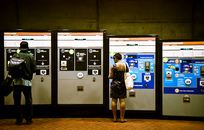Is blocking negative SmarTrip balances really necessary?

Photo by ep_jhu on Flickr.
WMATA announced a surprising set of changes to SmarTrip: riders will no longer be able to “go negative” a few dollars, like they can today.
Why is WMATA making this change? At a recent meeting, the Board asked for the price of SmarTrip cards to be reduced from $5.00 to $2.50. According to many groups that serve low-income riders, the price of a SmarTrip card is a burden for some.
The recent fare hike included a new differential between SmarTrip and paper farecards, in an attempt to charge casual riders (like tourists) more than regular riders, but that makes SmarTrip ownership even more necessary.
The current arrangement lets riders still leave the system if their fare costs more than the amount on the card, but they can’t enter the system if the card has gone negative. In other words, if you have $1.50 on your card and take a $3.25 trip, the faregates will let you out and your card will show -$1.45, but you will have to refill the card before you can ride again. This avoids the need for riders to use the Exitfare machines to get out, which only take cash (and currently don’t work with SmarTrip at all).
However, if cards only cost $2.50, riders might be able to buy a card, spend more than $2.50, and throw the card away, basically cheating Metro. Therefore, WMATA plans to change the system so that negative balances are no longer allowed. Exitfare machines will start working with SmarTrips, but they still will only take cash.
Some of you warned about this when the SmarTrip cost reduction was announced. However, I agreed with Jamie, who argued this probably wasn’t a real danger:
Does anyone really see droves of people buying a new smart trip card for every Metro trip for the purpose of gaming the system on the order of, er, a dollar? Really? Have you even been to a CVS before? That would effectively double the time involved in any given trip.
You know, you can just jump the turnstile if you are among the tiny portion of society that gets off on small-scale heists. People do that often enough without having to go to CVS, and they save as much as $5 instead of just a buck!
[And] I don’t see someone trying to save a dollar on Metro fares laying down $100 or so in advance [to buy cards in bulk]. Totally conflicting mentalities.
Metro would almost certainly win, anyway, given they are holding that cash for some time and some of them will likely end up unused.
Since the cards still cost $2.50, people would not only have to take the time to buy all these cards, but be regularly riding them for trips over $2.50. Furthermore, CVS and Giant sell the cards for $10, including $5 of stored value (which will become $7.50 of stored value after the price drop). That makes it hard to pull this scam at most of the places SmarTrips are sold, unless these hypothetical fraudsters are willing to spend a lot of real legitimate money for every dollar they cheat WMATA out of.
I think it would have been better for WMATA to keep allowing negative balances, and instead of spending a lot of time and contractors to reprogram the machines and add SmarTrip targets to the Exitfares, just have someone run an analysis of the numbers of negative SmarTrips that get abandoned (such as never used again within 6 months). If it turns out to be more than a tiny nuisance, then go ahead and make this change. Otherwise it might be much ado about nothing.
As an alternative, I wonder if WMATA could program the faregates to not let a rider in with a balance of $0 (or, perhaps that’s already the case). Then, a rider can’t just buy 20 cards and use each one for a throwaway ride costing more than $2.50. Instead, they’d have to buy the cards, take the time to put $1 on each card, and then take each one for a rider costing more than $3.50.
Would anyone really do that to save at most $1.45 a trip ($5.00 max fare minus 25¢ SmarTrip discount plus 20¢ peak-of-the-peak)?
Probably the easiest place to pull this would be for riders at more distant stations with parking, since those stations allow easy purchase of SmarTrips and many rides from those stations indeed cost over $2.50. If this turns out to be a real problem, perhaps there are some easier solutions that are more targeted, like selling cards there for $5.00 with $2.50 of stored value already on them. Or WMATA can just go ahead with this change once it becomes clear it’s a problem. I still doubt it will start an epidemic.
On another note, I suspect the Board will be irritated to hear about this, because unless I missed the discussion, it didn’t come up when they were suggesting the change. At the time, staff told them that cards cost about $1, but then later corrected that to say they cost $3.40.
In other words, they initially made the decision believing they were still selling the cards for more than cost and that it wouldn’t force any other changes, but instead, WMATA will lose money on each card, and riders have been inconvenienced, possibly unnecessarily.
